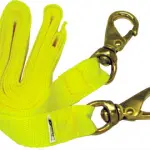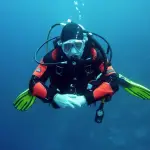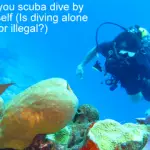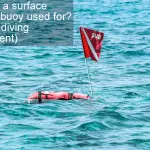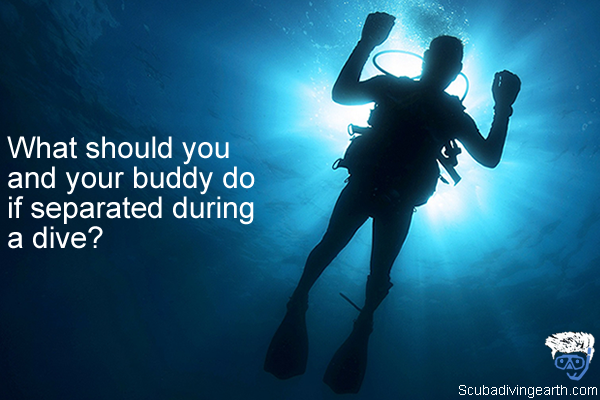
How to avoid buddy separation on a dive
One of the top rules of scuba diving is the buddy diving system, which means you should never dive alone. However, there may be a time when you get separated from your buddy. If you do get separated from your dive buddy, what should you do?
The quick answer if you get separated from your dive buddy during a dive, is to stop and do a slow visual 360-degree spin. In doing so always remember to look up and down too. Look for telltale signs like your buddy’s bubbles or any disturbance of silt or sand on the bottom.
Additionally, if you have an audio buddy signalling device like a tank banger or a similar, and if you can’t spot your buddy, use it to see if your buddy can locate you from the sound.
The best way to do more diving and to practice your skills is to book yourself on a scuba diving liveaboard. You can check the latest and best deals on liveaboards using the following window:
What to do in case of dive buddy separation
If you should lose sight of your dive buddy during a dive, you should both do the following:
- At the point you discover you’re alone on a dive and you’ve separated from your dive buddy(s), you should stop immediately.
- Do a slow visual 360-degree spin.
- Remember to look both up and down too during your 360-degree spin.
- Look for telltale signs of your buddy’s location, for example look for your buddy’s bubbles or for any disturbance of sand or silt.
- If you can’t see your buddy by sight and if you are carrying an audio buddy signaling device, use this to see if your buddy can locate you from the sound. This could include for example a tank banger or similar.
- Listen out for any sounds that your buddy may be making with a similar device. But understand that it’s not always easy to locate where sounds are emanating from underwater.
- If you’re in low visibility or on a night dive use your dive light when carrying out your slow 360-degree spin. The beam of your light may be enough to penetrate further and grab the attention of your buddy who may be behind an outcrop or other underwater feature.
- Only spend 30 seconds to a maximum one minute looking for your buddy and don’t go swimming in search of them.
What to do if you don’t find your dive buddy after one minute of looking:
- After your 30 seconds to one minute of looking using the 360-degree search technique, ascend to the surface slowly. Remember to perform your safety stop, also continue to look for your buddy by spinning as you ascend.
- While at your safety stop, deploy your delayed surface marker buoy (DSMB) or safety sausage. This will allow your buddy to easily spot you if they are looking for you at the surface.
- Once on the surface, perform another 360-degree spin, looking in all directions for signs of your missing buddy.
- If you’re diving from a boat dive or a liveaboard dive boat, return to the boat and immediately inform the crew that you’re missing your buddy.
- If you are on a shore dive and if your dive buddy doesn’t appear, as soon as you reach the shore inform the coast guard about your missing dive buddy.
- At the surface if you don’t find your buddy, never re-descend once you’ve surfaced from your dive.
- Assuming your missing buddy has carried out the same dive buddy separation procedure, they should appear on the surface either just before you are shortly afterwards.
- If you find your buddy either on your ascent or at the surface, don’t descend again, unless you spot your buddy before you’ve ascended more that a few metres or feet.
Standard Safe Diving Practices for scuba divers under the PADI system
Under the PADI system, you are always taught to dive in buddy pairs and in a blog article on the PADI website on standard safe diving practices, point five quotes:
“Adhere to the buddy system throughout every dive. Plan dives – including communications, procedures for reuniting in case of separation and emergency procedures – with my buddy.”
Standard Safe Diving Practices for both Scuba Divers and Freedivers – PADI
More Reading: 26 Rules For Safe Scuba Diving (Safety Tips To Become a Better Diver)

Safe Diving Guide – Going diving with BSAC
Under the BSAC (or British Sub Aqua Club) safe diving guide, they also preach diving in buddy pairs too. On the BSAC website on their Safe Diving Guide in the section on ‘separation’ they state the following:
“You should agree with your buddy what you will do if you become separated underwater.
If you lose sight of your buddy remember that divers have a blind spot directly behind and above them, so look behind and above you first.
If separated underwater, make a brief attempt (approx. 30 seconds) to re-locate your buddy, after which the divers should surface. Continue to look around during the ascent.
If you re-join your buddy either during the ascent or on the surface consider carefully your decompression requirements before you decide to re-descend. You will almost certainly be increasing your risk of Decompression Illness (DCI).”
Safe Diving Guide – Going diving – BSAC
Having looked at what you and your dive buddy should do if separated during a dive, let’s take a look at what factors can lead to dive buddy separation in the first place.
Factors that may lead to dive buddy separation:
The following factors could make a buddy separation more likely:
Strong currents during a drift dive
This is because you are both moving fast and if either of you stop to look at something, the other person may be out of sight very quickly.
Poor visibility
Poor visibility diving makes it extremely easy to lose sight of your dive buddy. Therefore take extra care in this scenario to keep in sight of each other. In very bad visibility situations use a buddy line or tether to link you together.
But always consider abandoning the dive if the visibility gets dangerous to continue or where the enjoyment of the dive is compromised.
Low visibility combined with a drift dive
This is an added risk of both the above scenarios and I’d recommend using a buddy line or tether in this case. Or if you don’t have these, hold hands and consider ascending and aborting the dive.
Wreck diving
If you are penetrating a wreck on a wreck dive this can sometimes make separation more likely. This is especially true where the visibility is low on the wreck.
Pay more attention to the whereabouts of your dive buddy. Underwater communication is key in this scenario to avoid buddy separation. But also the use of a buddy line may also be appropriate for safety reasons.
Cave diving
The same risks are true of cave diving as they are of wreck diving, as entering caves it can be dark. Communication is key and pre-dive planning is essential to avoid the extra dangers associated with cave diving.
Night diving
If you both have dive torches, it’s extremely difficult to lose a dive buddy on a night dive. However, if your buddy’s dive light fails it will be difficult to see them, which is why on a night dive you should stay close together.
It’s not recommended to do a night dive in a drift or current, nor would it be ideal to do a low-vis night dive either.
Equipment problems or malfunctions
Equipment failure can distract the person with the problem. During the distraction, it’s possible for their buddy to continue moving on and lose sight of their buddy.
Either you or your buddy gets distracted
Other distractions, and especially on a drift dive, can cause the separation of buddies on a dive.
Miscommunication during the dive
If during a wreck dive there’s some form of miscommunication, this could lead to a separation of buddies. This is why planning the dive and diving the plan is a key part of safe diving practices.
It’s true to say that the loss or separation from your buddy can cause serious anxiety. This is more likely if you’re a beginner diver if and when it happens.
More Reading: What helps with anxiety during scuba diving? (7 scuba anxiety relief tips )
However, by adopting a proper dive buddy separation procedure and by communicating this before you dive, will minimise the dangers of buddy separation on a dive.
More Reading: The best liveaboard diving for beginners (10 top liveaboard destinations)
How to avoid buddy separation on a dive
The best approach when scuba diving is to avoid buddy separation on a dive in the first place. But what are the top tips to avoid buddy separation on a dive?
- Stay within 3-4 metres (10-13 feet) of your buddy on good visibility dives.
- Stay within sight on low visibility dives and therefore reduce the distance in point 1. above to whatever is necessary to stay in sight of each other.
- Consider a buddy line or tether in extremely low visibility or in stronger drift dives. Or simply hold hands to avoid separation and if conditions get really bad abandon the dive.
- Check on your buddy on a regular basis, I recommend every 2-5 minutes.
- Be aware of your blind spot, as your buddy may be behind you.
- Always discuss separation protocol before you dive, especially when diving on a drift dive or on a low visibility dive.
- If you are planning a wreck penetration dive, plan this carefully before you dive to avoid any miscommunication whilst on the dive.
- Always consider abandoning the dive in dangerous scenarios that may cause you to separate.
Do you have to dive with a buddy?
Having looked what to do in case of dive buddy separation, let’s quickly cover the question about buddy diving and whether you can dive alone.
Technically, or by the letter of the law. it is possible to dive alone. There are no scuba police to stop you from diving on your own. It’s also true to say that some people do dive alone, when they know they shouldn’t!
However, in scuba certification lessons when you learn to dive, one of the main scuba safety rules is to never dive alone.
More Reading: PADI vs SSI vs NAUI vs BSAC (Differences & is one certification better?)
I hope you enjoyed this article about what should you and your buddy do if separated during a dive
I’d love to hear from you. Tell us about your adventures of diving and snorkeling, in the comments below. Please also share your photos. Either from your underwater cameras or videos from your waterproof Gopro’s!
If this article hasn’t answered all of your questions. If you have more questions either about snorkeling or scuba diving (or specifically about what should you and your buddy do if separated during a dive), please comment below with your questions.
There will also be many more articles about scuba diving (and snorkeling) for you to read and learn about these fabulous sports.
Have fun and be safe!

